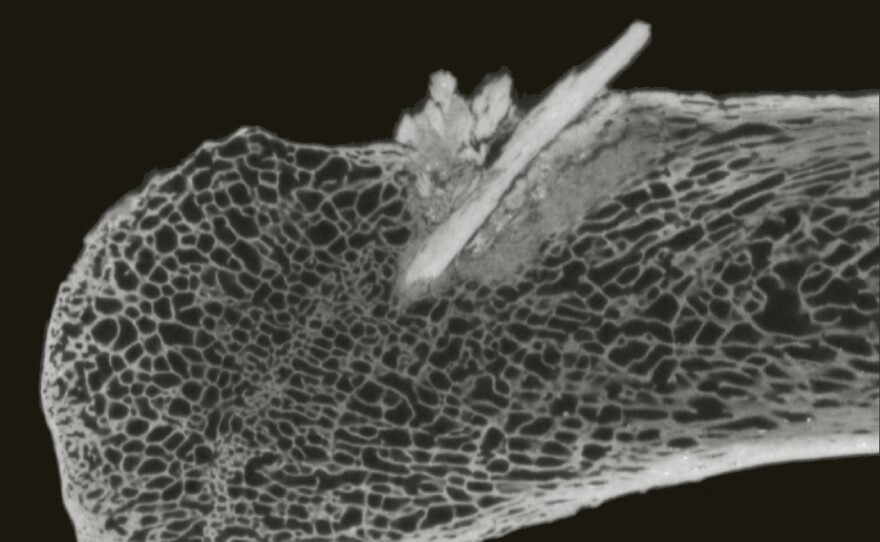More than 13,000 years ago, hairy elephant-like creatures with giant tusks roamed North America. These mastodons were hunted by some of the earliest people to live here, and scientists recently learned a bit more about those mysterious cultures by taking a new look at an old mastodon bone.
This particular mastodon took his last breath in what is now the state of Washington, on the north side of the Olympic Mountains. His bones rested underground until the late 1970s. "It was discovered by accident," says Michael Waters, director of the Center for the Study of the First Americans at Texas A&M University, who explains that a farmer was excavating with his backhoe.
Washington State University scientist Carl Gustafson excavated the bones. "What he discovered there was a single mastodon. It was an old adult male; it was laying on its left side," says Waters.
The bones had cut marks that suggested humans had butchered the animal. One rib looked particularly interesting: X-rays showed that wedged inside was the point of a spear, made from antler or bone.

This CT scan image shows a section of mastodon rib where researchers found a spear point lodged in the bone. The spear would have passed through more than 10 inches of hide, tissue and muscle.
At the time, most scientists didn't believe humans lived in North America that early, so they said it couldn't be that old. Others said maybe it wasn't even a spear point.
"You know, it was suggested at one point that this may have been an elk antler tine that somehow got into the bone, like there was an angry elk that charged the elephant," says Waters.
Waters wanted to revisit this intriguing find using modern technologies, so he called Gustafson.
The now-retired professor went to his basement, retrieved the rib, and put it in the mail. Waters and his colleagues got to work. "We can do high-resolution CT scanning of the bone, and we can even do DNA analysis," says Waters, "and that's exactly what we did."
Studying The Spear Tip
The CT scans let them build a 3-D model of what was stuck inside the bone. It is a spear point, says Waters. "You could clearly see that the piece had been sharpened to a sharp tip and that the tip had broken off upon impact and rotated a little bit off to one side." He says that type of breakage is often seen in stone spear tips.

A spear point is embedded near the end of this mastodon rib bone.
The research team also confirmed that the ancient hunt happened 13,800 years ago.
This isn't the first evidence that humans were living in the Americas this early. In recent years, scientists have been pushing back the date that people first set foot here. But Waters says they don't know much about those communities of hunter-gatherers.
"I think what it does is it just provides additional evidence and fills a little bit out about the picture of people here before Clovis," says Waters, referring to the Clovis culture that appeared hundreds of years later.
The distinctive hallmark of Clovis is a beautifully crafted spear point made of stone. Writing in the journal Science, Waters and his colleagues say this mastodon kill indicates that earlier people might have relied on bone weapons.
And apparently, they could orchestrate a sophisticated attack on a massive beast, sticking a spear through its thick hide and around 10 inches of muscle.
The new date on the bones is convincing, says Jonathan Haas, an expert on the ancient Americas at The Field Museum in Chicago. "And I think that that was an extremely interesting time in North America, as people were beginning to colonize an open continent. That's what I think is particularly interesting about this story."
Haas says back then, America was a wild, still unexplored place where animals like mastodons probably didn't even know to run when they saw a small band of humans creeping closer, carrying spears.
Copyright 2022 NPR. To see more, visit https://www.npr.org. 9(MDAzMjM2NDYzMDEyMzc1Njk5NjAxNzY3OQ001))







